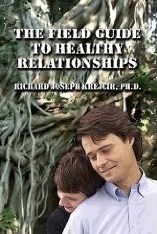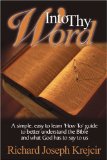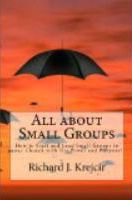The opportunity is yours to put more into it if you have the time. If you are in a pinch all you need to do is read through it first and go for it, the Lord will use you! But as with anything important, the more effort the "more" of results you will receive in your own life and then impart on your students.
So the hard part is the maturity of the leader, the easy part is teaching the subject. So spend time in prayer for the Lord to use you, for Him to guide you, read through the material and go for it in love and grace, because He loves you and will use you!
Remember we cannot do the work of God unless we are the People of God, we cannot teach what we do not do!
The Format:
The student workbook is laid out for you to study on your own individually (which I strongly recommend before teaching it), or to use it in large groups, and small groups. It is very flexible. It is designed for high school through young adults, but many older adult groups will benefit from it too. You can customize it for most any situation: For youth groups, small groups, Sunday school, retreats, or personal study. The student workbook is the "how too" into God's Word. It contains the essential elements written in an outline format, with ample scripture references. It is designed for the student to go through it alone or in a group. You can give it to your students in advance, maybe two weeks so they can read through and familiarize themselves with it, or you can just jump in. "It is user friendly."
THERE ARE THREE MAIN SECTIONS TO THIS STUDY:
1. Sessions I through VI "The why and importance of the Bible."
You can cut this part down. Some teachers will only do half of this first section for time constraints. But if it is for a lack of interest, you have a problem. I feel this would be unfortunate because many young people today hunger for spirituality but cannot find it anywhere. They may have been in churches or families that in the name of Christ have been abused by them. Or have been influenced by the secular mindset, or just do not want to give up their rights to themselves.
But if we do not have a love for what we are doing and a strong reason and purpose, we will soon leave it behind. Let us not leave God's Word behind!
2. Sessions VII through XIV Is the "How to read the Bible."
This Is based on the "Into Thy Word Steps" what I will call the "Workbook," which is the "how" to exegete and know Scripture. For these lessons you can use a computer software program and print off a chapter of Scripture in different translations such as the NIV, KJV, NASB, and various paraphrases. Romans 12 is a good one to start with, lots of stuff to dig into. Or you can dig into a smaller Book, such as II, III John, Jude or…it's up to you.
3. Session XV is the "Chart"
This is the "How" to put into practice all the steps. This can be one lesson, as an overview, or you can use it to go through a book of the Bible, or if you are ambitious the whole Bible (may take you 10 years). Make copies of the Chart for each student, have a supply of Bibles and resource books, see Appendix C.
The leaders guide:
The leaders guide is divided into 7 sections for each lesson.
First is the bible study "Leaders Study" for the leaders to work through issues essential for leading this study and for personal discipleship and edification. Thus the thrust of the leader's study is to prepare yourself to teach, and to reach the people the Lord has sent to you. We have to be the people of God in order to do the work of God.
Second is the outline of the lesson with approximate times. Now each group is different, as some love to talk and discuss and others will sit there like cows staring at you. Remember there are more questions and activities than the normal time of a class will allow, so plan accordingly. Perhaps as you go over the material, mark the parts your students need to know and make sure you have time to cover them. Save the rest for when you have time, or go back to it after a year or so as review.
Third: This is the opening option where a story or activity designed to start off the subject for that day and set the tone. Give them something to start their leaning process, leading to how they will know it and then apply it to their lives. You may not need to do this section with some older adult groups, because they may just want to jump right in. Find out from your group how they would like to proceed. For additional story helps, get the Books, "Hot Illustrations for Youth Talks" by Youth Specialties. There are 3 volumes, or go to the web site "Youthpastor.com."
Fourth: Is the "curriculum" in the student workbook. You can use this as your "talk," or you can have people read it in advance (good luck with short attention span teens!), or you can read it in the class, or have students read it (give it to them a week in advance, this works great with teens). I have found it best for the teacher to read it, and give sections to your students to read. It all depends on your group. Steps VII to XV can be a group effort, as you can combine the talk and discussion together. Because you will actually be studying and digging into a text, thus learn as you do as you teach.
It is a good idea to give the scriptures to various students in advance to read aloud when called on. Make sure they are comfortable to read in public and they are not wasting class time looking up the passages. Have them booked marked and ready. (Of course looking up passages is never a waist of time, it is more of time management. Five (5) minutes spent looking up passages is five (5) minutes taken away from discussion and application.)
This takes the "teacher show" approach away and gives more of the learning over to the students themselves. Power point works wonders with this or any study, just type in the key pints (bullets) and click away as you give the lesson.
Fifth: Is the discussion questions. They are designed to be done in a small group setting, but again can be used individually or in a large group. I recommend you break into groups of 4 to 6, you do not need adults if you are teaching high school students as long as you come back for questions and answers. They are capable to lead themselves with guidance and support. There are specific questions to ask your students to spur discussion, and to get them thinking and challenge them into the Lord's service. (Service is an outgrowth of discipleship, a response of gratitude to the grace we have been given that covered our guilt and fallen separated nature. God's Word will challenge and lead people to the Lord's path, it will convert, convict and teach. The only thing to worry about is not to get in the way of God.) The discussion for the first several sections are questions in 4 parts:
First is an "opener" to spur thinking and get people talking.
Second is a "to know it" where we are going over the essential information we are learning.
Third is "getting deeper" by changing the way we think from our way to God's way, thus taking ownership of what is being taught.
Fourth is the "application", sometimes a homework assignment, or something to ponder (thinking deeper).
The rest of the sessions are designed as an adventure to dig into the "steps," learning by doing!
These questions can be tailored to age and time constraints, along with sections to go deeper in their spiritual life. You can put them in your own words. Later on, there will be charts to incorporate what was learned, and to use in their personal devotions and study. Encourage students to make use of them, and not throw them out, as they progress they can see it as a journal on their spiritual walk.
Sixth: This is the "Going Deep" section and it can be used in the small group or back in the large group after the Q&A. They are "Spiritual exercises" to help us to engage and deepen the classic Christian disciplines of silence, solitude, study, prayer, worship, sacrifice and celebration. I suggest that you bring them back as a large group for this section until they feel comfortable in the small groups. Staying in a large group will bring your group deeper in their collective spiritual life, and more community and depth to your group dynamics. Keep in mind this may not work with some people (especially multigenerational Christians in a constrained church). They may feel uncomfortable. Just reassure and encourage them, and when they are ready, try it again. Some people are just not ready for deep spiritual stuff.
You can find other examples of contemplative Christian exercises such as the "Jesus Prayer," "Lectio Divina," the "Ignatian Awareness Examen" and other classic forms of prayerful attention. Most of these are, or have been practiced in Monasticism (monks and nuns), and were "the baby that was thrown out with the bath" by the reformation. Calvin and Luther both practiced these all of their reformed lives, and Calvin wrote extensively on their benefit!
You may find these recourses in a Catholic bookstore. The ones in this series were designed by me over the years and are not from catholic resources.
In a contemplative approach to youth and adult ministry, churches engage in exercises that help them become more aware and attentive to God's presence and call in their lives.
Going deeper requires "baby steps," that is you may not be able to do this section all at once. You may start off with some of the aspects in this leader's guide depending on the spiritual maturity of the leader and the students. Not behavior maturity, although this is important, but rather spiritual maturity, the depth that we have gone in our personal walk with prayer, study of His Word, and devotions.
I strongly suggest that the leader experience and work through these issues first before challenging their group with them. You cannot lead where you have not been!
As a result of using classic devotions, most project churches report a "spiritual awakening" among young people in their congregations!
As one 15-year-old states, "I feel a greater sense of God's presence in my life … a warm flame has become ignited that was not there before."
If you are not going to be using the "going deep," then remember to pray as you normally do, and try to incorporate the "going deep" gradually. You can repeat them from various sections, or use them as they are. These lessons are designed to take students into a deeper ownership of their spiritual journey, and a deeper commitment to what is being taught and learned. This is what Christ called us to do, to make disciples, and grow closer to Him. We cannot just rely on our beliefs and actions because we have to be a changed person before we can model changes to ourselves and then others!
Seventh: "The Close:" This is the last section after the small groups where you can do the "going deep," close in a song, or in prayer, or both. You can have a question and answer time (this I strongly recommend) to go over what is being missed in some of the discussion groups. You can go over the main points of the lesson, or share what you are learning and growing in. I have found it best to have a quick question and answer session first then do the "Going Deep." And if you do not know the answer, it's okay. Just find out from your pastor, apologetical book, or Internet source and get back to them by the following meeting. Then go over and remind them of the application challenge, close with the "Going Deep" and then in prayer. There is no set way or right way, it is up to you, what your group needs, and their maturity level. Just remember the importance of prayer.
So How Do I Start?
First read through the student's workbook (the first part of this book), then the leaders guide section by section as you get ready to teach it. It is best to at least skim the whole thing too, to give you a general overview. After you have gone over it, highlight the sections and options you will do, and go over in the "lesson" section and pick the points you wish to cover. You may not have enough time to cover it all. You can make it into a talk, re-say it in your own words, just read it with interest and excitement, let them read it themselves, or read it like "Jeopardy" questions. Be creative! Do not spend too much of the class time with this, even though it is the most important part of the lesson. Encourage the students to read the section in advance before the class.
Do not be overwhelmed, this is a 15-week curriculum (which can be extended, especially if you go through a whole epistle after completing the 15-week sessions), so go step by step. You should at least be going over the section you are teaching first before you teach. And you should have read the entire workbook before you start this series, so you know were you are going. You do not need to know every detail ahead, just the general theme, as you get close to each new section, then re-read it and you will pick it up fast. Each section builds on the previous section. (If you are worried that if a student misses a session they will be lost. They could be, but encourage them to spend 15 minutes reading through the student workbook what they have missed, and they will be fully caught up!)
You may spend a couple of hours doing this whole overview before you begin to teach this series. Then before each meeting spend as much time as you can in prayer, and at least 20 minutes reading over the section. You will find it will almost teach itself! But as with anything, the more prepared you are the better the outcome will be.
The format is up to you and your teaching style. You can just have a discussion with the workbook by having everyone read a chapter before they come, use this curriculum as is, or customize it. If you are new to teaching, I suggest you follow it. This series has more questions and options than normal time constraints will allow. The reason is simple, sometimes groups will not engage in discussion, the extra material is to prevent dead air. Or, sometimes the students want more, so you can give it to them to take home. Every group is different. Sometimes special resources are suggested that you do not have time to get or forgot, that is why we have several options! Or if they skipped a week, all the pertinent information is in the student workbook.
You may want to extend the number of meetings for a deeper walk into His Word. Or you can mark off what you did go over, and a year latter come back to this series and cover what you did not do before with a general introduction, and go through a book of the Bible. This reinforces the importance of this study and gives time for their minds to develop and practice what they have learned. So when you come back to it, more discussion should develop, as their experience has increased.
To be a successful leader and discipler, we have to dispel the myth of trying to be popular or eloquent. We need to be real, to do our best, and have a passion and love for what we are teaching and to those who we are teaching. And to begin we need to know what maturity is all about, because if we do not get this important facet, all we try to model and teach will unravel and be meaningless to those we are trying to teach.
© 2000, Rev. Richard .J. Krejcir Ph.D. Discipleship Tools www.discipleshiptools.org










